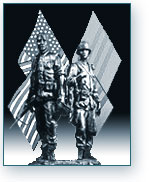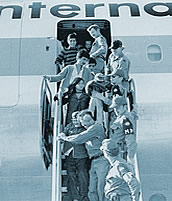Continued from page 1
 U.S. Intervention and The Vietnam War U.S. Intervention and The Vietnam War
The first large-scale intervention by the United States in the region occurred when the U.S. both paid for the majority of France’s war costs and provided direct aid to countries in the region. The U.S. also helped France provide humanitarian relocation and relief assistance by resettling 800,000 refugees from North Vietnam to South Vietnam.
America’s foreign policy and intervention in the region were dictated by its Cold War efforts to contain the spread of communism in Southeast Asia and other countries, predicated on the “domino theory.” The U.S. was concerned with both communist influence from the former Soviet Union in the region and China’s establishment of a communist regime in 1949. The U.S. was already involved by 1950 in the Korean War, which began after communist North Korea, supported by Chinese forces, invaded pro-republic South Korea. During this Cold War era, the U.S. government followed a containment strategy in Southeast Asia, employing an “Americanization” policy that included sending military trainers to Vietnam.
In 1965 U.S. troops were sent to help the South Vietnamese military, called the Army of the Republic of Vietnam (AVRN). They were fighting against pro-communist forces, namely the North Vietnamese Army (NVA) and the National Liberation Front (NLF), commonly known as the Viet Cong (VC), who were infiltrating the southern region. This marked the beginning of the Second Indochina War, known as the Vietnam War to Americans, yet called the American War by many Vietnamese.
The War Spreads
This war would spread to neighboring Cambodia and Laos. Direct bombings in these countries destabilized them politically and economically, including by displacing civilian populations. The U.S. had earlier engaged ethnic groups in these countries to assist in the war effort. The fighting became intense in the late 1960s and early 1970s, when the U.S. military and the South Vietnamese waged a “secret war” in a strategic attempt to defeat the North Vietnamese Army and the Pathet Lao, a guerrilla communist force, in Laos. As part of this covert action in the late 1960s, the U.S. military and the Central Intelligence Agency (CIA) recruited Hmong and Iu-Mien ethnic groups from the highlands of Laos, who were known for being fierce soldiers, to provide intelligence information and to fight alongside the U.S. backed Royal Lao Army in the anti-communist offensive. These ethnic minority groups thought they would gain autonomy and preservation of their territory by assisting the U.S.

|


